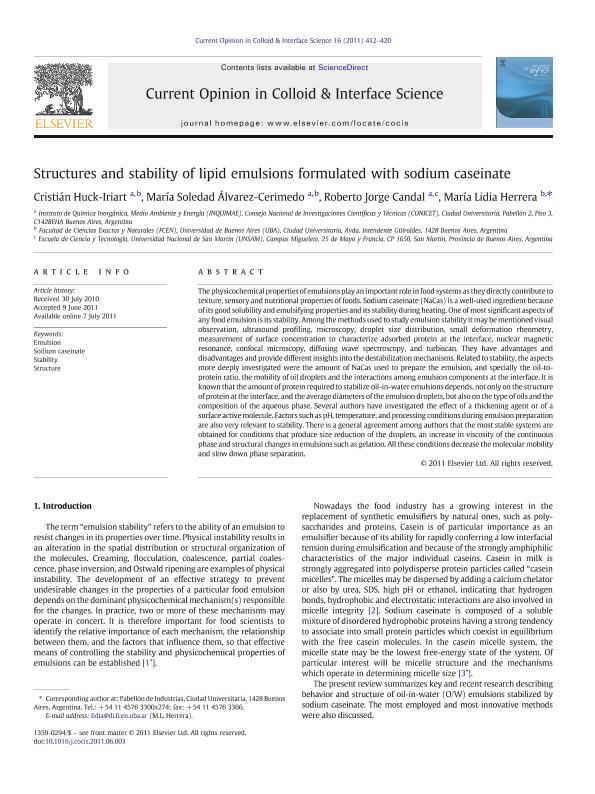Artículo
Structures and stability of lipid emulsions formulated with sodium caseinate
Huck Iriart, Cristián ; Álvarez Cerimedo, María Soledad
; Álvarez Cerimedo, María Soledad ; Candal, Roberto Jorge
; Candal, Roberto Jorge ; Herrera, Maria Lidia
; Herrera, Maria Lidia
 ; Álvarez Cerimedo, María Soledad
; Álvarez Cerimedo, María Soledad ; Candal, Roberto Jorge
; Candal, Roberto Jorge ; Herrera, Maria Lidia
; Herrera, Maria Lidia
Fecha de publicación:
05/2011
Editorial:
Elsevier Science London
Revista:
Current Opinion In Colloid & Interface Science
ISSN:
1359-0294
Idioma:
Inglés
Tipo de recurso:
Artículo publicado
Clasificación temática:
Resumen
The physicochemical properties of emulsions play an important role in food systems as they directly contribute to texture, sensory and nutritional properties of foods. Sodium caseinate (NaCas) is a well-used ingredient because of its good solubility and emulsifying properties and its stability during heating. One of most significant aspects of any food emulsion is its stability. Among the methods used to study emulsion stability it may be mentioned visual observation, ultrasound profiling, microscopy, droplet size distribution, small deformation rheometry, measurement of surface concentration to characterize adsorbed protein at the interface, nuclear magnetic resonance, confocal microscopy, diffusing wave spectroscopy, and turbiscan. They have advantages and disadvantages and provide different insights into the destabilization mechanisms. Related to stability, the aspects more deeply investigated were the amount of NaCas used to prepare the emulsion, and specially the oil-to-protein ratio, the mobility of oil droplets and the interactions among emulsion components at the interface. It is known that the amount of protein required to stabilize oil-in-water emulsions depends, not only on the structure of protein at the interface, and the average diameters of the emulsion droplets, but also on the type of oils and the composition of the aqueous phase. Several authors have investigated the effect of a thickening agent or of a surface active molecule. Factors such as pH, temperature, and processing conditions during emulsion preparation are also very relevant to stability. There is a general agreement among authors that the most stable systems are obtained for conditions that produce size reduction of the droplets, an increase in viscosity of the continuous phase and structural changes in emulsions such as gelation. All these conditions decrease the molecular mobility and slow down phase separation.
Palabras clave:
Emulsion
,
Sodium Caseinate
,
Stability
,
Structure
Archivos asociados
Licencia
Identificadores
Colecciones
Articulos(INQUIMAE)
Articulos de INST.D/QUIM FIS D/L MATERIALES MEDIOAMB Y ENERGIA
Articulos de INST.D/QUIM FIS D/L MATERIALES MEDIOAMB Y ENERGIA
Citación
Huck Iriart, Cristián; Álvarez Cerimedo, María Soledad; Candal, Roberto Jorge; Herrera, Maria Lidia; Structures and stability of lipid emulsions formulated with sodium caseinate; Elsevier Science London; Current Opinion In Colloid & Interface Science; 16; 5; 5-2011; 412-420
Compartir
Altmétricas



